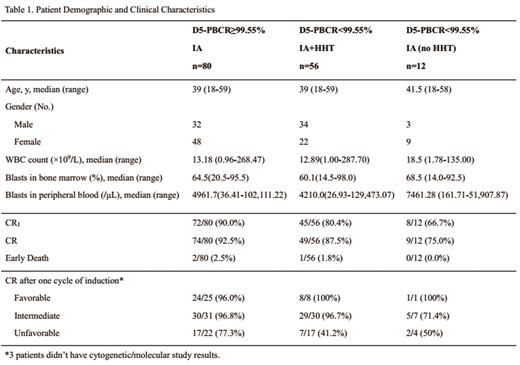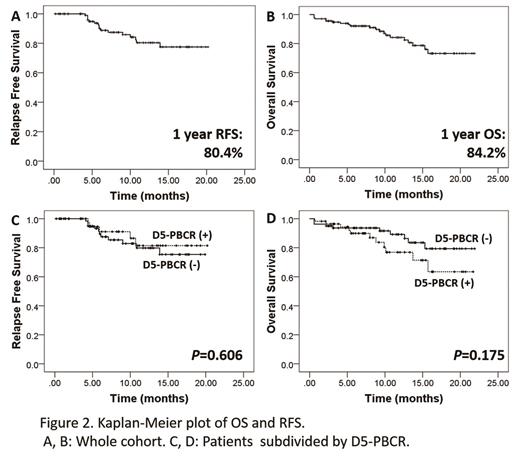Abstract
Background: Combination of idarubicin and cytarabine (IA) is now the basis of induction treatment for acute myeloid leukemia (AML) while the complete remission (CR) rate is only 60-75%. Homoharringtonine (HHT) based regimen was proved to be an option for AML and may improve long-term survival [1]. As previously reported, we established an effective evaluation of early treatment response by monitoring peripheral blast through flow cytometry, and concluded that patient with Day 5 peripheral blast clearance rate < 99.55% (D5-PBCR +) carries poor prognosis [2]. Thus we designed clinical trial to testify if HHT addition can reverse the unfavorable outcome of these D5-PRCR (+) patients. And here we report the latest response and survival results for this study.
Patients and Methods: This clinical trial was designed using single arm Simon stage II model. We hypothesized the CR rate may increase 15% by addition of HHT, and then sample size of D5-PRCR (+) patients who need to combine HHT should be 55. Between 2014 and 2016, 148 patients (pts) aged 18-59 years old with newly diagnosed de-novo AML were enrolled in the RJ-AML 2014 trial (Fig.1). All patients received induction with standard IA regimen (idarubicin 10mg/M², d1-3; cytarabine 100mg/M², d1-7). Peripheral blood samples were collected before and on day 5 of induction. D5-PRCR was calculated as previously reported. Pts with D5-PRCR (+) were assigned for additional chemotherapy (HHT 2mg/M²£¬d6-10). Pts in CR were offered four cycles of intermediate-dose cytarabine (cytarabine 2g/M², every 12 hours, d1-3) for consolidation. And pts with NCCN unfavorable cytogenetic/molecular risk were recommended for allo-HSCT. The trial is registered in the Chinese Clinical Trial Register, number ChiCTR-OPC-15006085.
Result: Baseline characteristic including age, white blood-cell count and bone marrow blast were similar between D5-PRCR (+) and D5-PRCR (-) groups. And patients with intermediate-unfavorable risk were more likely to be D5-PRCR (+). 68 pts were D5-PRCR (+), and 12 pts were unfit for HHT addition due to severe infection or unstable haemodynamics. Thus, 56 pts received HHT for induction. The CR rate among all pts was 86.03% (CR1: 117/136) after one course of induction. The CR1 rate for D5-PBCR (-) group was 90% (favorable: 96.0%, intermediate: 96.8%, unfavorable: 77.3%) and D5-PBCR (+) group was 80.36% (favorable: 100%, intermediate: 96.7%, unfavorable: 41.18%). And the CR rate of all pts was 90.44% after two courses of induction [D5-PBCR (-): 92.5% vs. D5-PBCR (+): 87.5%, P=0.329]. Compared to our previous results, CR rate was significantly increased for D5-PBCR (+) patients by HHT addition (87.5% vs. 56.14%, P=0.006) [2]. For the 12 pts with D5-PBCR (+) and were unfit for HHT addition, CR rate was only 66.67% after one courses of induction which is similar to our previous (P=0.502). 60-day early mortality rate was 2.5% for IA and 1.8% for IA+HHT. (Table. 1) The duration of neutropenia and thrombocytopenia were similar (P>0.05) and the incidences of non-hematologic toxicities including hepatic, renal, cardiac and gastrointestinal were not significantly different (P>0.05). Estimated overall survival of all pts at 1 year was 84.2% and relapse free survival was 80.4%, no statistical difference were found between two groups (Fig.2).
Conclusion: This study was the first proposed trial of early induction intervention based on residual peripheral blast level in AML. Our current results indicated that IA+HHT is a well-tolerated regimen for younger AML pts. And the addition of HHT may benefit intermediate risk patients, reverse the insensitivity to traditional IA regimen and improve long-term survival. It still require longer follow-up to conclude more detailed and reliable result.
1. Jin J, et al. The Lancet Oncology. 2013; 14(7):599-608.
2. Yu C, et al. Journal of Hematology & Oncology. 2015; 8(1).
No relevant conflicts of interest to declare.
Author notes
Asterisk with author names denotes non-ASH members.




This feature is available to Subscribers Only
Sign In or Create an Account Close Modal